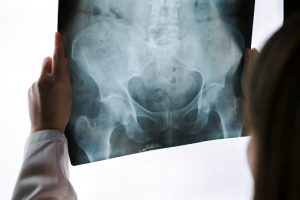 Phleboliths are masses of varying sizes found in a vein within the pelvic area. They are composed of lime or calcium deposits, with their presence possibility hinting at a more serious underlying condition or disease.
Phleboliths are masses of varying sizes found in a vein within the pelvic area. They are composed of lime or calcium deposits, with their presence possibility hinting at a more serious underlying condition or disease.
However, phleboliths are typically harmless unless a more serious underlying condition is discovered that requires immediate medical attention.
Advertisement
Phleboliths are difficult to diagnose, as symptoms often resemble other more common conditions. Most of the time, phleboliths are not discovered until a radiograph or x-ray catches a glimpse of one when performing testing for some other unrelated condition.
How phleboliths are caused
Possible causes of phleboliths include:
Pressure in veins: This occurs when pressure builds up in vessel walls due to urinary phleboliths. Injury of any kind to the vein walls caused by vein pressure can lead to the development of phleboliths.
Varicose veins: Considered a symptom of phleboliths, varicose veins may cause them as well. Varicose veins are overstressed, dilatated veins that can lead to blood vessel damage and phlebolith development.
Bowel movements: Due to consistent straining of bowel movements. This can lead to increased blood pressure and create problems that result in phlebolith development.
Liver disease: In addition to the other problems that liver disease can cause, it may also lead to the development of phleboliths in your abdominal organs.
Other causes: Phleboliths are associated with benign tumor growth in young people. These include stomach cancer and other gastrointestinal tumors.
Symptoms related to phleboliths
Pain: Commonly experienced in the pelvis area but may occur in the lower back or abdomen. The pain is often very similar to that experience by kidney stones.
Thrombosis: Due to blood flow slowing down leading to its eventual blockage.
Varicose condition: Phleboliths can lead to pelvic vein dilation and subsequently to the development of varicose veins. This is often be accompanied with pain in the pelvis as well.
Kidney/bladder discomfort: A common symptom of phlebolith development. This symptom can help locate the approximate location of the causative phlebolith.
Diagnosis and treatment of phleboliths
Diagnosis of phleboliths is often incidental, being found when not looking for them. It is often seen on an x-ray of the pelvis when performing the test for another unrelated condition.
Treatment will depend on the severity of your phleboliths. Most cases will be treated with minimally invasive treatment options such as anti-inflammatory medications, but in extreme circumstances, more invasive medical procedures may be deemed necessary due to significant discomfort.
Some treatments for severe phleboliths include:
Sclerotherapy: A treatment used for treating venous malformations by shrinking veins. It is not considered a permanent solution and will likely have to be repeated on multiple occasions.
Endovascular laser therapy: With the use of tiny laser fibers, physicians are able to close problematic veins. It was found that endovascular laser therapy is also efficient at removing phleboliths.
Surgical excision: In the most extreme of cases, the last option is to have a surgeon directly expose the problem area in an operating room to remove the vein completely, along with the surrounding tissue.
Preventing phleboliths
The following are healthy lifestyle recommendations that may help prevent future development of phleboliths.
Avoid prolonged inactivity: This often occurs when we choose to sit for long periods of time or primarily live a sedentary lifestyle. Taking a short walk, stretching your arms and legs, and getting up off the couch will help get
the blood flowing and help prevent phleboliths and its complications.
Avoid tight clothing: One of the most common problems leading to phlebolith development. Avoiding tight clothing around the waist is especially important.
Stay hydrated: Drinking plenty of water every day will help prevent dehydration. If dehydration were to occur, it would create an environment that increases blood pressure, possibly leading to phlebolith development.
Phleboliths home remedies
While it is possible to manage phleboliths with the following recommendations, it is always advised to speak to a trained medical professional to get the best treatment possible and avoid complications. The following are some things you can do on your own to help alleviate the problem.
Advertisement
Apply wet washcloth: Wet your wash cloth with warm water and apply to the affected area. This will help to alleviate discomfort associated with phleboliths.
Elevate the affected area: Raising the area of discomfort — above the heart if possible —will reduce the flow of blood through the area and help mitigate pain.
Anti-inflammatory medication: Great for helping to reduce pain, these types of medication can be also prescribed by your doctor to help your specific pain needs.
